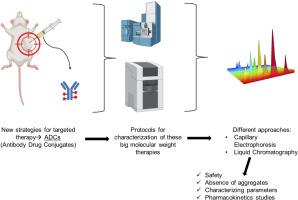New analytical challenges in characterization of antibody-drug conjugates
IF 3.2
引用次数: 0
Abstract
Since 1913, when Paul Ehrlich introduced the concept of “selective toxicity”, new strategies to obtain quality control, quantification of the drug were mandatory. For this reason, the introduction of antibody drug conjugates (ADC) has shown many critical points, being these systems made of small- and high-molecular weight compounds. Being ADCs a novelty for showing therapeutic action, they were subjected to a grow up in studies. There are in literature several approaches to follow ADCs for in vivo and in vitro studies because type of conjugation, release of the drug, and body-distribution are characteristic for each of them, resulting in many critical steps.
Liquid chromatography (LC) and capillary electrophoresis (CE) are the most common analytical technique used in order to obtain the aim. For the characterization of ADCs, there are several chromatographic techniques. HPLC finds application in both small and large molecules, related to the availability of various modes of separation (reversed-phase, size exclusion, ion exchange, mixed-mode etc.). Capillary electrophoresis (CE) finds its main application in large molecule therapeutics, where its electrophoretic separation mechanism offers a distinct, and often superior, separation of macromolecules compared to classic chromatographic techniques. Several modes of CE, including capillary electrophoresis sodium dodecyl sulphate (CE-SDS), capillary zone electrophoresis (CZE), and capillary isoelectric focusing (CIEF) or imaged capillary isoelectric focusing (iCIEF) are commonly utilized in characterization of the critical quality attributes (CQAs) of monoclonal antibody drugs such as charge variants, size variants, and positional isomers/purity etc.
In this review, analytical methods for physicochemical characterization of ADCs will be reported and analysed in order to highlight as the chromatographic procedures allow obtaining a complete ADCs evaluation and characterization.

抗体-药物偶联物表征的新分析挑战
自1913年保罗·埃利希(Paul Ehrlich)引入“选择性毒性”概念以来,获得药物质量控制和定量的新策略是强制性的。由于这个原因,抗体药物偶联物(ADC)的引入已经显示出许多临界点,这些系统由小分子量和高分子量的化合物组成。adc作为一种显示治疗作用的新事物,在研究中受到了广泛的关注。文献中有几种方法可以跟踪adc进行体内和体外研究,因为每种方法的结合类型、药物释放和体内分布都具有特征,因此需要许多关键步骤。液相色谱(LC)和毛细管电泳(CE)是达到这一目的最常用的分析技术。对于adc的表征,有几种色谱技术。HPLC在小分子和大分子中都有应用,这与各种分离模式(反相、尺寸排除、离子交换、混合模式等)的可用性有关。毛细管电泳(CE)主要应用于大分子治疗,其电泳分离机制与经典色谱技术相比,提供了独特且通常更优越的大分子分离。毛细管电泳(CE- sds)、毛细管区带电泳(CZE)、毛细管等电聚焦(CIEF)或成像毛细管等电聚焦(iCIEF)等方法是单克隆抗体药物关键质量属性(cqa)表征的常用方法,如电荷变异、大小变异、位置异构体/纯度等。将报告和分析adc的物理化学表征的分析方法,以强调色谱程序允许获得完整的adc评估和表征。
本文章由计算机程序翻译,如有差异,请以英文原文为准。
求助全文
约1分钟内获得全文
求助全文
来源期刊

Journal of chromatography open
Analytical Chemistry
CiteScore
2.50
自引率
0.00%
发文量
0
审稿时长
50 days
 求助内容:
求助内容: 应助结果提醒方式:
应助结果提醒方式:


